How to make Water Kefir! A happy, bubbly, fruit-infused sparkling water, that is packed full of healthy probiotics that will energize the body and support the gut.
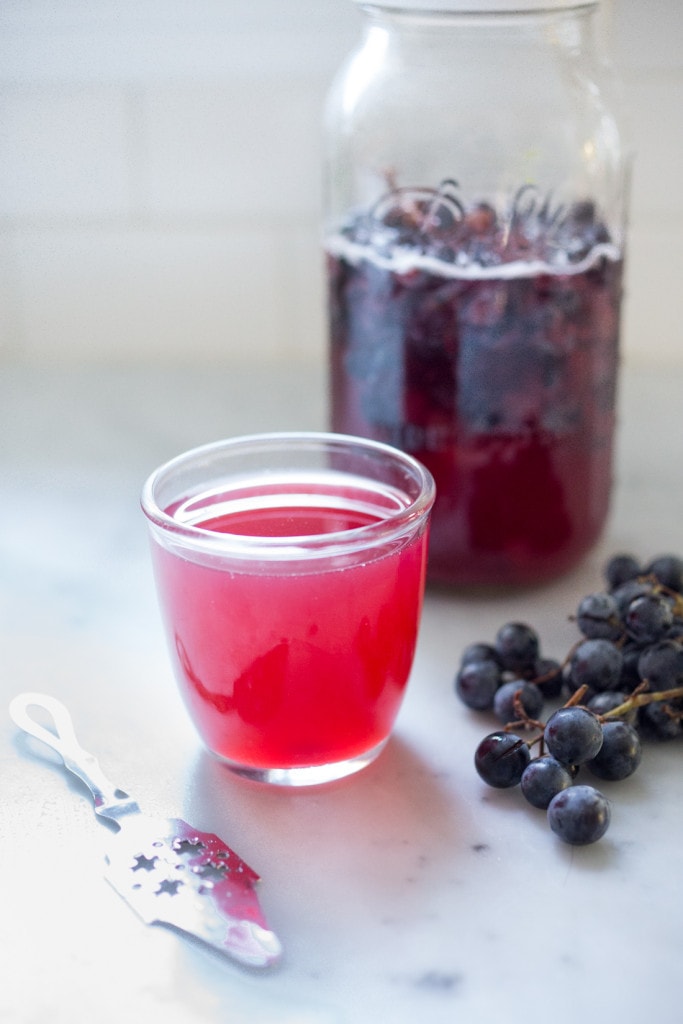
I want to introduce you to a happy, bubbly probiotic drink called water kefir!
This delicious, effervescent, fruit-infused water si full of healthy probiotics that support a healthy, diverse microbiome, clears the skin, and energizes the whole body. It’s similar to kombucha but without the caffeine!
The best part is that it is easy to make at home! I hadn’t heard of water kefir until a friend of mine, Bee (from H is For Love), introduced it to me a few years ago, and since then, I’ve been crazy, head-over-heels in love with it. We’ve been making batches and batches of this refreshing, healthy beverage all summer long.
But First, What is Water kefir?
- Fermented, fruit-infused water, similar to kombucha in that it’s slightly fermented and effervescent-but water kefir is fermented with live water kefir grains, which are a yeast-bacteria that believed to originate from the pad of a cactus plant in Mexico.
- Water kefir is completely different from Milk kefir. Not only is this a dairy-free probiotic, it’s gluten-free.
- Water Kefir Grains are “fed” with sugar and actually metabolize (consume) the sugar, making the final drink very low in sugar!
Watch How to Make Water Kefir
How long does it take to make kefir water?
It takes about 3-4 days to make Kefir Water, with only 15 minutes of hands-on time!
Water Kefir Ingredients
- Water Kefir Grains -This is the starter culture that ferments the water. Soft and gelatinous “grains” (a combination of yeast and bacteria) believed to originate from Mexico where they were found attached to the Ountia cactus (prickly pear) thriving from the cactus’s sugary water. Purchase Water kefir grains in the refrigerated section of your health food store, or purchase online, and read the package directions to fully activate them before starting! This may take a week- or may come already activated.
- Sugar – Types of sugar include organic cane sugar, coconut sugar, jaggery, molasses, sucanat, brown sugar, raw sugar, turbinado, piloncillo (evaporated sugar cane juice in a cone-shape found in Mexican markets). White sugar is very mineral deficient so I try not use it- or only in a pinch.
- Fruit – fresh fruit and berries are ideal here. Juicy ripe stone fruits ( plums, peaches, nectarines, cherries, etc.) fresh berries (strawberries, huckleberries, blackberries, blueberries, etc.) Pineapple, apples, pears, or Frozen fruit, or fruit juice will work too.
- Water- Tap water or well water is generally best when making water kefir- or use “still” mineral water. Hard water is better than soft water here! Filtered water, reverse osmosis water, or soft water or highly chlorinated water can actually inhibit fermentation. Distilled water tends to lack minerals that feed the kefir grains.
- Lemon Slices – to prevent kahm yeast.
- Unsufulerd Prunes- optional, to boost fermentation- or sub-dried figs, unsulfered apricots, or other dried fruit.
- 2-quart mason jars ( you will need 2-3 jars)
- A strainer
- A kitchen towel
How to make Water Kefir
- STEP ONE: Fill two, 2-quart mason jars to the halfway mark.
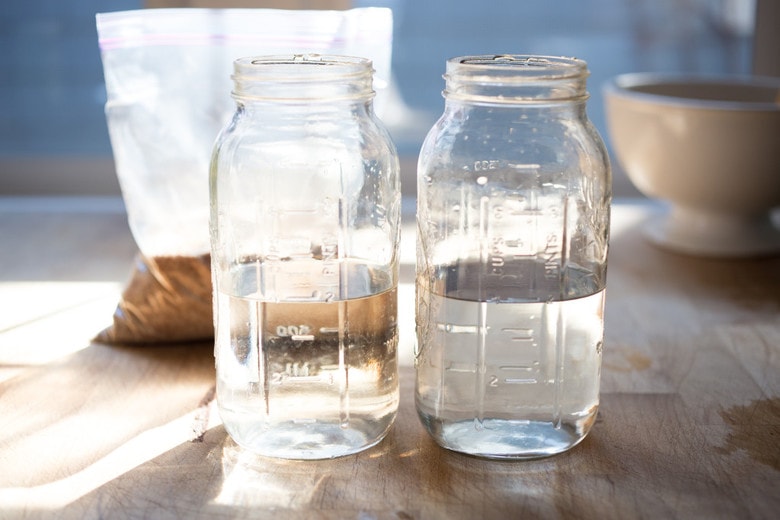
STEP TWO. To the water, mix in ¼ cup of organic cane sugar into each jar. I highly recommend making the “sugar mixture” in the recipe notes which contains more minerals (than white sugar) which keep the grains happy and help with fermentation.
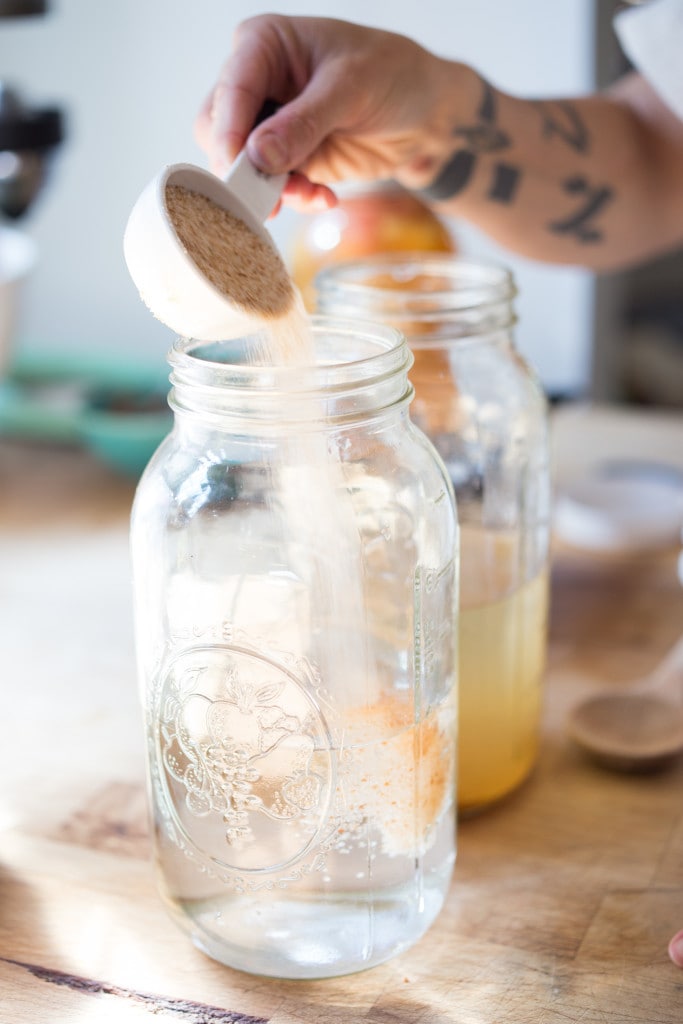
Now before you start thinking (like I did) that there is so much sugar in this, and how it must be so high in calories, remember, the kefir grains metabolize the sugar, which means they basically “eat” the sugar, (this is what feeds them) taking it out of the water. Once it’s done doing its thing, the water is only very mildly sweet, which I find completely and utterly fascinating!
Where does the sugar go?
From Yeemos: “Kefir grains are an amazing symbiotic matrix of bacteria and yeast that work together to feed off the natural sugars (and sometimes proteins and fats too, especially in the case of milk kefir) found present in the sugar-water and dried fruits. The yeast and bacteria cooperate, making the nutrients that are inaccessible to one digested into accessible nutrients for the other. Yeasts break down the simple sugars like glucose and fructose, turning them into ethanol and acetic acid. Lactic and acid-producing bacteria (such as lactobacilli) convert sugars (such as sucrose) and complex carbohydrates (starches, etc) into simpler sugars and lactic acid. Lactic and acetic acids naturally preserve as well as stave off harmful foreign bacteria. The result is a drink that has had much of the sugar converted to simpler sugars, lactic and acetic acids, carbon dioxide and ethanol. It also contains millions of probiotics and is more nutritious in some regards because of the more bio-available and digestible nutrients from the sugars and dried fruits including an increase in vitamin C and many B vitamins.” From Yemoos
Stir the sugar into the water with a wood spoon until dissolved.
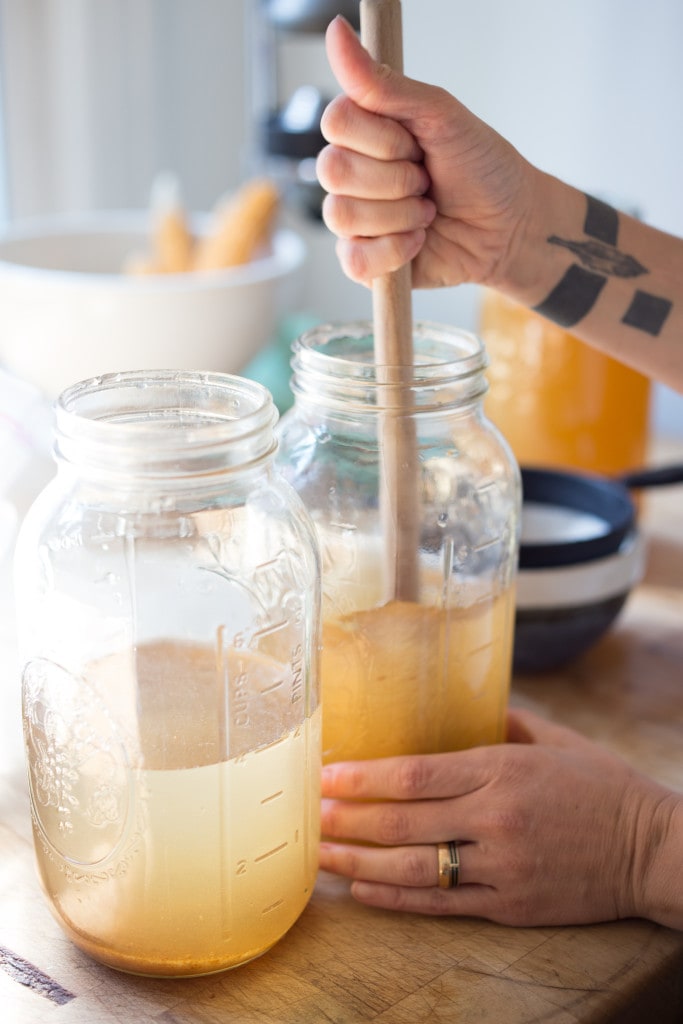
STEP THREE: Add 1/4 cup water kefir grains to each jar. Gently stir.
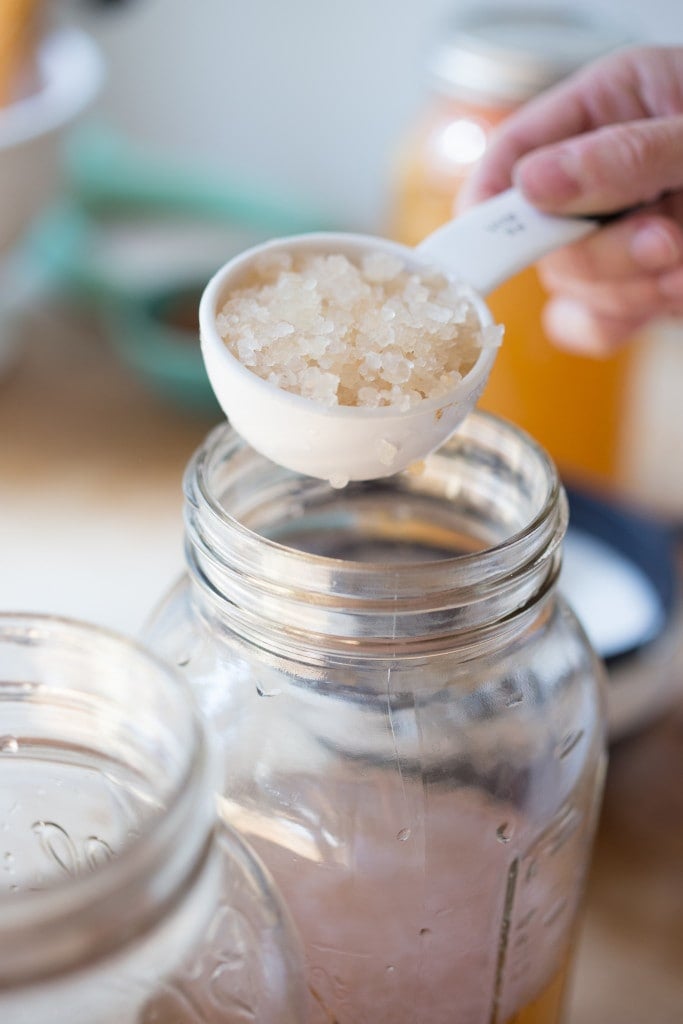
STEP FOUR: Add a big slice of lemon to each jar. Now if you are allergic to lemons, sub orange, lime or even grapefruit. The acidity here helps prevent the growth of Kahm yeast – a harmless yeast but one that could affect the taste.
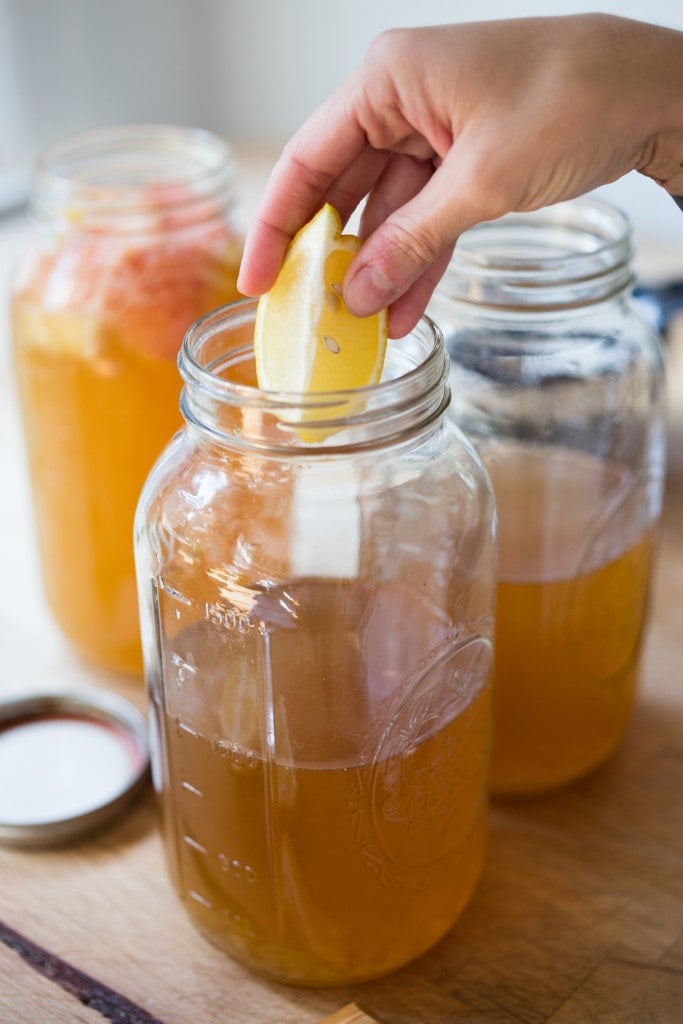
STEP FIVE: Add one prune to each jar. These seem to also boost fermentation. They are not imperative, but definitely add if you have them on hand. A dried fig, or a few raisins would work too.
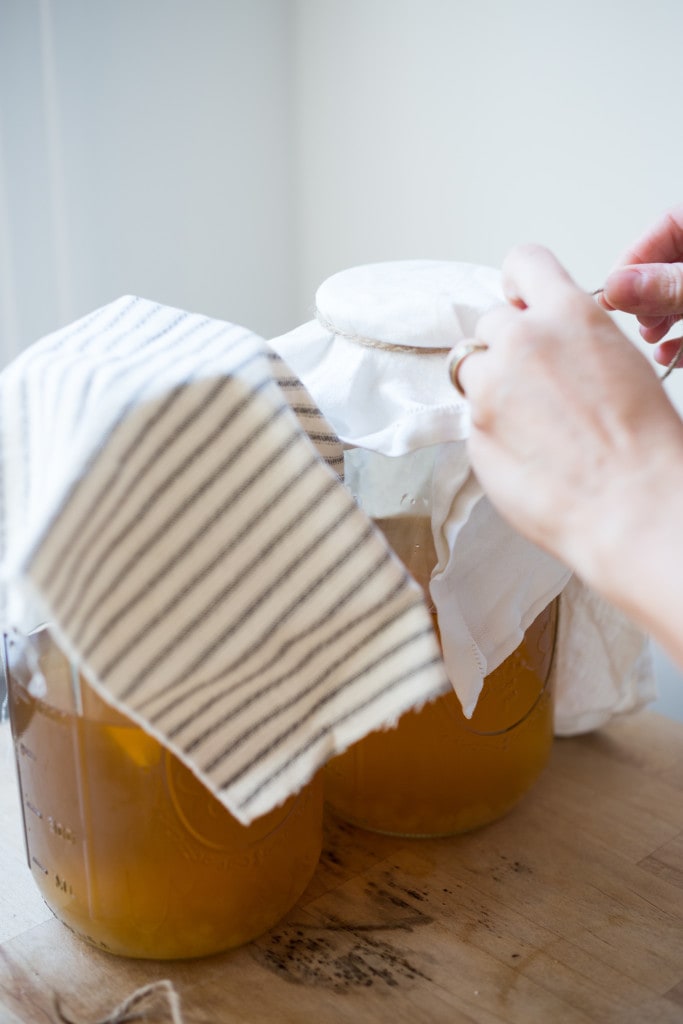
STEP SIX: Cover with a thin kitchen towel. It needs to breathe, but you want to prevent little fruit flies from getting in and seal it with twine or a rubber band. You could also top it with a coffee filter.
STEP SEVEN: The First Ferment. Let the jars sit on the kitchen counter at room temperature for 2-3 days. Two days if it’s warm out (in the summer), 3-4 days if it’s cold. Right now in fall, I’m leaving it out for 3 days.
Check for sweetness. After 2 or 3 days your kefir water should have fermented slightly – and you can check this by tasting it. If it tastes very sweet, then the sugar has not been metabolized and you need to ferment it longer. The longer it goes, the tangier it will taste and the less sweet it will get. You want it to taste balanced- just subtly sweet with a little bit of tangy. Find your own balance. If you taste no tanginess, it may not have fermented, a sign the kefir grains may not be healthy, active or alive.
TIP: Tangy or sour flavors tell you it has fermented. If it is not getting tangy or sour after 3-4 days, then your kefir grains may not be alive or active.
STEP EIGHT: Create your flavor. Place 1 – 1 1/2 cups fresh fruit in one clean 2-quart jar– like fresh berries, peaches, apricots, pineapple, plums, concord grapes, apples or pears. You can also add fresh herbs. Then strain both jars of the fermenting kefir into the third clean jar with the fresh fruit in it, straining out the kefir grains (set these aside) filling the jar to a ½ inch from the top. (Save the extra fermented water to store the grains in and place them in the fridge with 1 tablespoon sugar. Add more water to cover.)
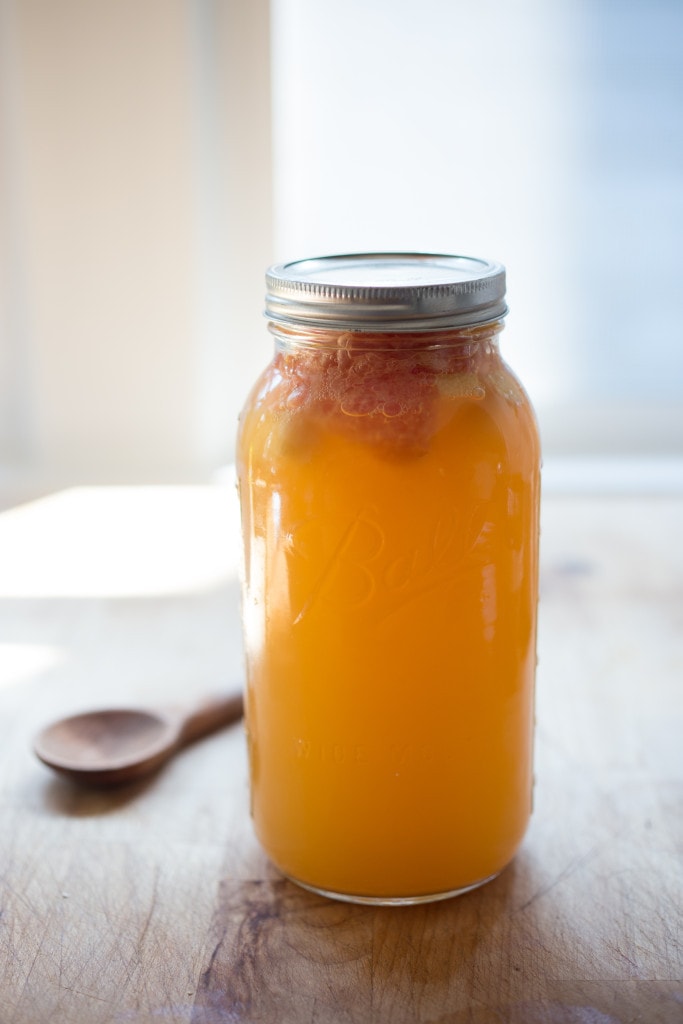
STEP NINE: The Second ferment. Once the fruit is added, cover tightly with a lid, and leave on the counter for another 24 hours. Your kefir should start bubbling. During the 2nd Ferment, the water kefir is creating gas and building pressure, which you want it to do – this makes it nice and bubbly, but with the metal lids, you must let out some of the pressure, “burping it” every 6-12 hours or so (depending on the temperature in your kitchen) so the lid doesn’t explode open (yes this happened to me). With a plastic lid, it stays on fine, and the air can escape. If using a metal lid, just screw the top on loosely until you feel the first resistance- this will allow some air to escape.
WARNING: These metal lids like in the photos above, have pros and cons. They allow pressure to build up, with their tight seal, creating bubbly effervescent kefir, but they can explode if the pressure is not released occasionally. They must be burped! If you need to leave your home and are worried about the jar exploding, simply loosen the lid while you are gone. Place the jar over a bowl to collect any runoff.
Plastic lids are “self-burping”, which if you are away from home for over 8 hours, I would recommend using. The downside is the plastic lids do not let the pressure build quite enough in my opinion so kefir is not quite as bubbly. Sometimes I switch between both, depending on if I am planning to be gone.
STEP NINE: After 24 hours, the fruit will float the surface and it’s time to refrigerate. You can strain the fruit, eat the fruit ( it won’t hurt you) or keep it in the water to infuse longer – I generally just leave it in, and strain it as I pour into a glass. Up to you.
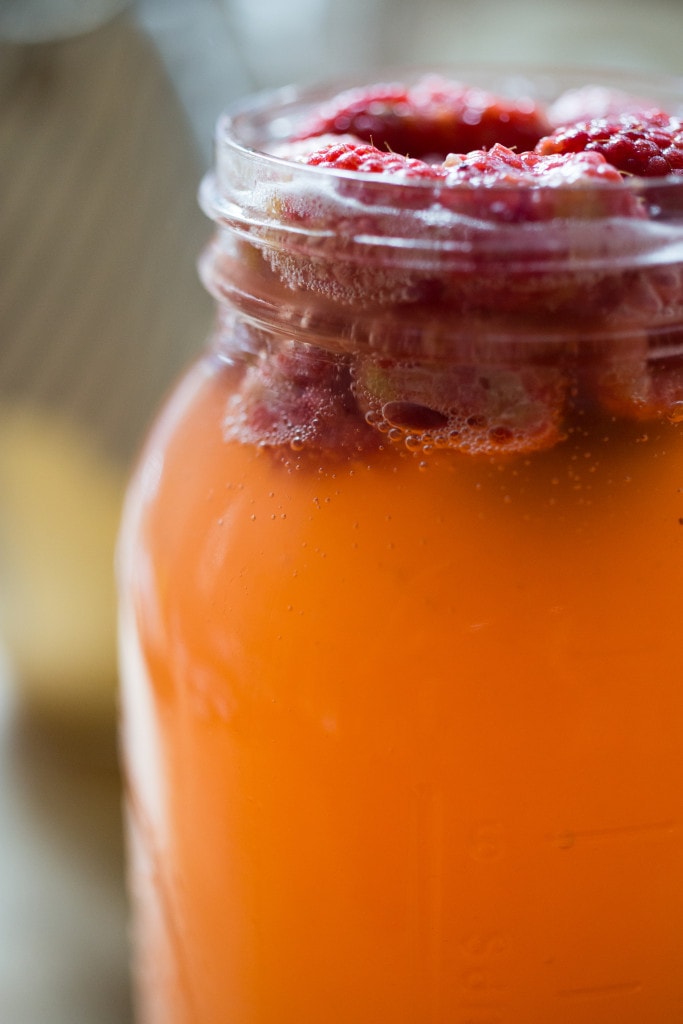
Troubleshooting Water Kefir:
- If you see a white yeast on top of your second ferment, it is most likely kahm yeast. Kahm yeast is harmless but can affect the taste in an unpleasant way.
- If you have Kahm yeast, make sure to rinse your kefir grains in pure clean water before storing in a clean jar with no soap residue. Cover with clean water and feed. This should hopefully prevent it from coming again.
- Make sure to add citrus to your kefir water, to help prevent Kahm yeast.
- Leave less headroom at the top of the jar for oxygen to get in, during the second fermentation (1/2 inch). Rinse your fruit before using, as this can also introduce the yeast.
- Sometimes Kahm yeast can grow when the environment’s temperature is too warm.
- If water kefir is not bubbling or not fermenting, it can be due to a lack of minerals. Use the mineralized sugar mixture, or try adding a pinch of sea salt.
How to Maintain & Grow Your Water Kefir Grains
- The kefir grains that you strained out earlier can be stored in a smaller jar, in the fridge in water or the extra water kefir, you will have after you merge the two jars into one. These grains will need to be fed weekly.
- When refrigerated, you want to feed the grains (with sugar) at least once a week, to keep them healthy and alive. They are happiest when they are actually making water kefir, so I just make one jar a week.
- If you want to make kefir water more often (or grow the grains faster so you can give some away) you can leave them out on the counter, feeding every two days.
- Feed 1 cup kefir grains with 1 tablespoon sugar, in 2 cups water, in the fridge once weekly. Feel free to change out the water every 2-3 weeks.
- The colder they are kept, the slower they will metabolize the sugar. The warmer they are, the faster they will metabolize the sugar- and will need to be fed more often.
- You can tell if the grains are “hungry” by tasting the liquid- if it is not sweet, but tangier, they are probably ready to be fed. If the water is sweet, they are not hungry and do not need to be fed.
- If the sugary water never gets tangy or sour (indicating fermentation) then your grains may likely not be alive or active.
Water kefir Flavors and Variations
Once you get the hang of making water kefir- the variations are truly endless! I usually start with what is in season- seasonal fruits and berries and add from there. You can also add herbs, spices and even chia seeds!
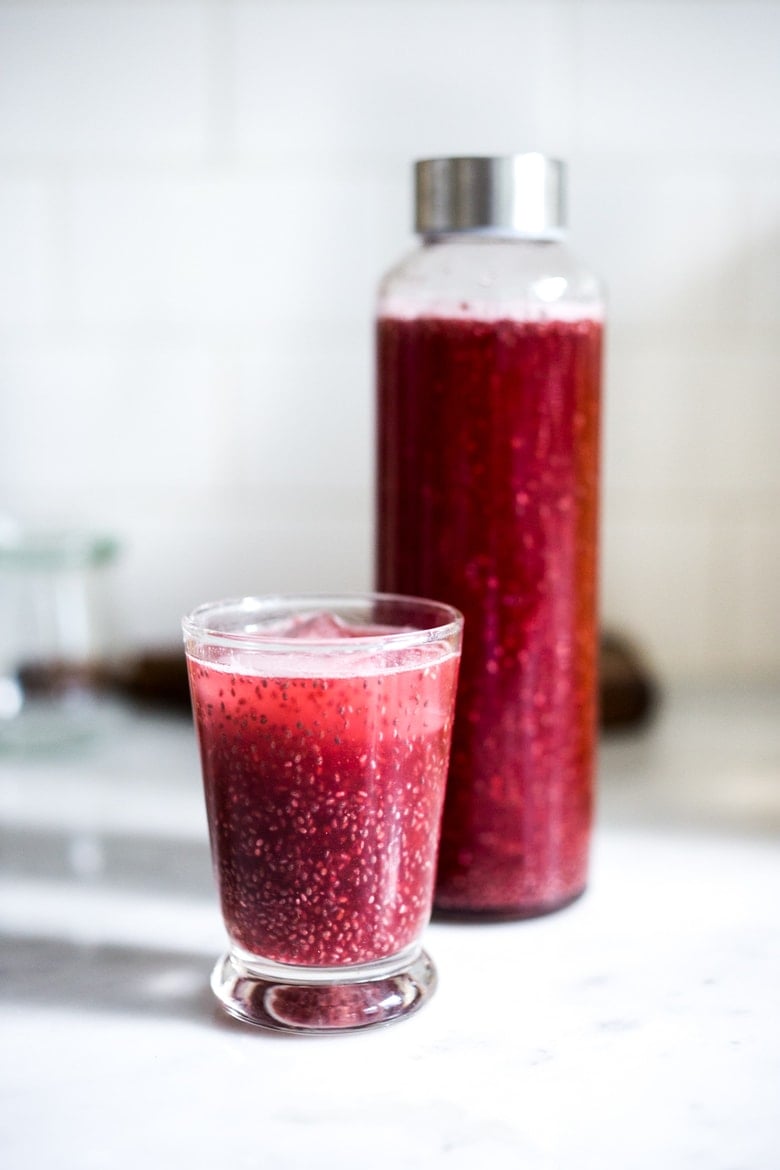
There are so many versions to make….. the possibilities are endless! Here above is Strawberry-Raspberry Water Kefir with Chia Seeds– energizing and refreshing!
Here below is peach ginger.
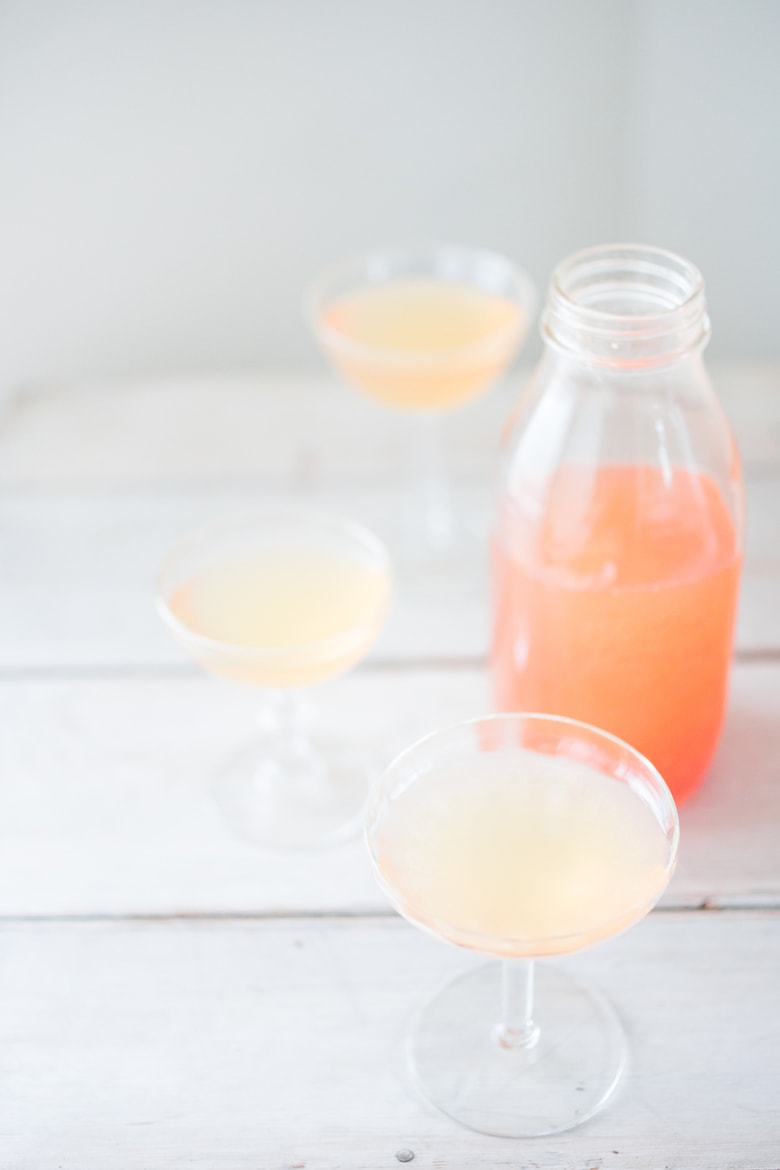
And here below is a Plum-Ginger Water Kefir with shiso leaves.
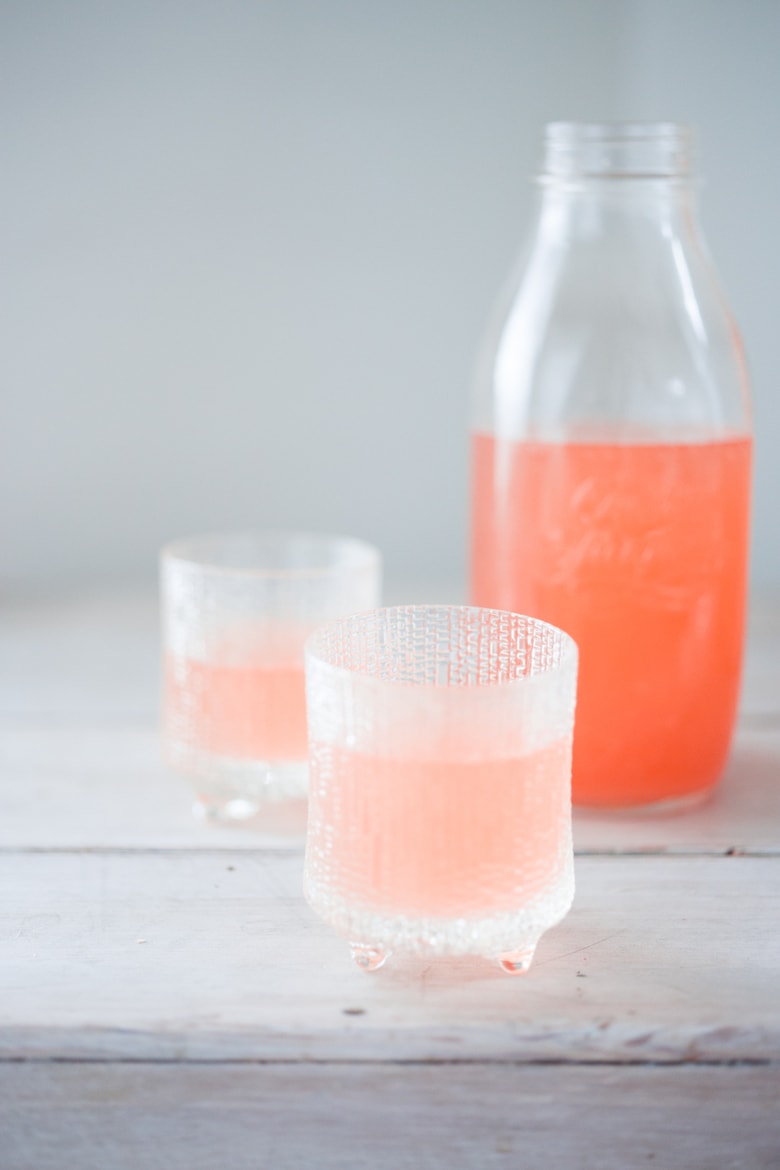
Here is Strawberry Basil Water Kefir!
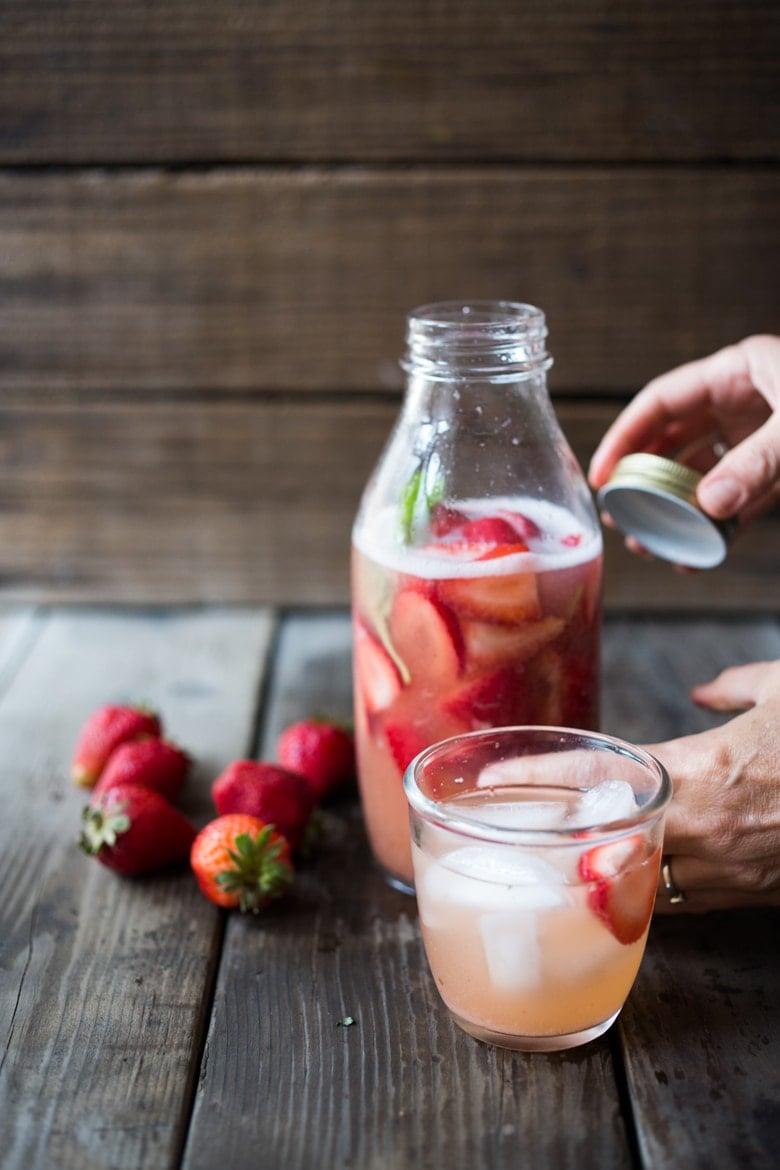
You’ll love how refreshing, tangy, fruity and delicious this is- so much better than a soda stream- with many more minerals, nutrients and probiotics.
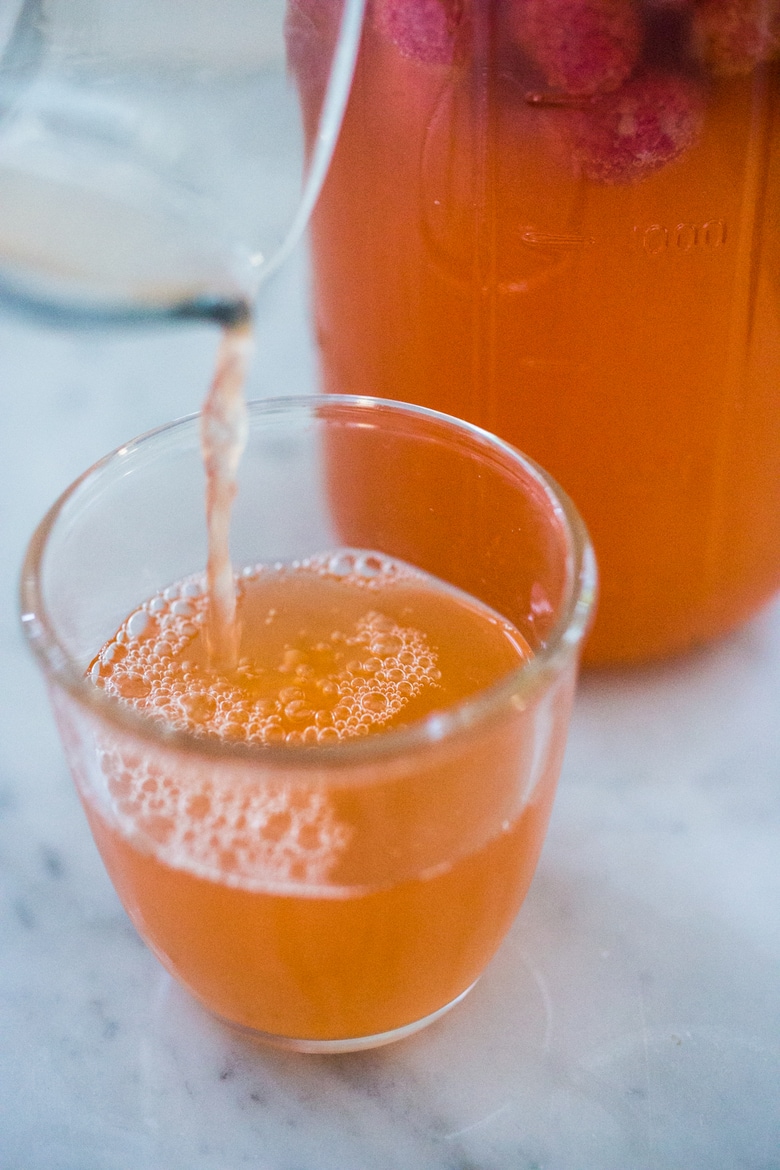
The possibilities are endless! Get some water kefir grains and give it a try!
Health Benefits of Water Kefir
More Fermented Probiotic Recipes
Water Kefir Faqs
Water kefir is full of healthy probiotics that increase the diversity of good bacteria in our gut, the foundation of a healthy immune system. It’s low in sugar, and full of nutrients from fresh fruit.
Water kefir is slightly fermented which can produce trace amounts of naturally occurring alcohol. This is typically around .02 % which equates to roughly ¼ teaspoon in a 12-ounce glass.
If your gut is healthy and diverse, yes! If you are new to consuming fermented foods, or have gut dysbiosis you may need to start off slowly and gently introduce it. Start with a few sips, and see how it feels, if ok, then try a quarter cup, see how you feel, and add from there. If you experience a lot of gas, bloating, back way down, and just take a sip or two daily until these symptoms go away.
Both kombucha and water kefir have health benefits- both contain healthy strains of probiotics. Kombucha contains caffeine from tea and aids with digestion. Water kefir is caffeine-free and typically contains more strains of good bacteria, though some believe not as potent- which may be beneficial for those new to consuming fermented foods- because they are gentler on the belly.
Enjoy the process and please share your flavors and adaptions in the comments below. ❤️
More from Feasting at Home
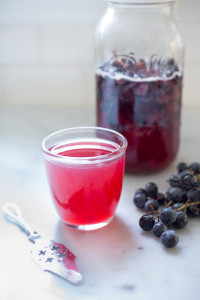
How to make Water Kefir
- Prep Time: 5 mins
- Cook Time: 72 hours
- Total Time: 72 hours 5 mins
- Yield: 8 cups
- Category: Drinks
- Method: fermented
- Cuisine: American
Description
A simple guide to making Water Kefir-a refreshing probiotic fruit-infused drink made with water kefir grains (cactus grains) that is bubbly, effervescent and so healthy!
Ingredients
- 1/2 cup alive water kefir grains
- 8 cups tap or well water- divided
- 1/2 cup sugar (divided) organic cane sugar, coconut sugar, or a ***mixture-see notes. ( FYI this will be metabolized or consumed by the kefir grains, so it will NOT end up in the finished drink!)
- 2 lemon wedges (optional)
- 2 prunes (or dates, or or dried fruit) optional
- ——-
- 1 –2 cups fresh fruit- berries, stonefruit (peaches, plums, nectarines), apples, pears, mango, pineapple, etc.
Optional Additions- fresh ginger, whole spices, herbs.
Instructions
- Fill two, half-gallon mason jars with 4 cups cool tap water in each.
- Add ¼ cup sugar in each, stirring to mostly dissolve. ( Feel free to make sugar mixture first)
- Add ¼ cup kefir grains to each jar.
- Add ¼ cup kefir water to each jar (optional–you can obviously only do this after your first batch of kefir, so just leave it out for the first batch.)
- Add ¼ of a lemon wedge to each jar.
- Add 1 prune to each jar.
- Cover both jars with a thin kitchen cloth and leave on the counter for 2-4 days. 2 days if warm out, 3-4 days if cold. This 2-4 day time period allows the grains “to eat” the sugar, so most of the sugar will actually be metabolized, and not end up in the drink itself. You want the water to get the point where it is just slightly sweet, and nicely tangy. So taste it before moving to the next step. If it tastes very sweet, it’s not ready. When it’s cold this takes longer.
- After 2-3 days the kefir will have fermented slightly, taste tangy or lightly sour, but there is one more step which gives it flavor and makes it effervescent and bubbly.
- FLAVOR: Get your third jar ready and place 1- 1 1/2 cups fresh, ripe fruit in it– like fresh berries, peaches, mango, pineapple, plums, concord grapes, apples, pears – I muddle them up a bit to release their juices. Add a few thin slices of ginger, or whole spices if you wish. Or add 1 cup fruit juice – especially nice in winter when fresh fruit is limited.
- Strain both jars of the fermenting kefir water into the third clean jar with the fresh fruit in it, straining out the kefir grains ( set them aside), tossing the lemon and prunes, filling the clean jar (with the fruit in it) to a 1/2 inch from the top. Then cover tightly with a lid, and leave this on the counter another 24 hours, allowing pressure to build up yet, burping the lids (releasing the pressure), every 8-12 hours or so, more often especially if warm. Keep in mind, not burping may cause the jar to explode. If you must leave them for longer, either loosen the lid and place jar in a bowl to collect runoff, or place the jar in the fridge, to slow the fermentation down, and continue fermenting on the counter when you have more time.
- WARNING: These metal lids like in the photos above, have pros and cons. They allow pressure to build up, with their tight seal, creating bubbly effervescent kefir, but they can explode if the pressure is not released occasionally. Plastic lids are “self-burping”, which if you are away from home for over 8 hours, I would recommend using. The downside is the plastic lids do not let the pressure build quite enough in my opinion so kefir is not quite as bubbly. Sometimes I switch between both, depending on if I am planning to be gone.
- To reiterate- During the 2nd fermentation phase, the water kefir is creating gas and building pressure, which you want it to do – this makes it nice and bubbly, but with the metal lids, you must let out some of the pressure, “burping it” every 6-12 hours or so, so the lid doesn’t bend or blast open (yes this happened to me). With a plastic lid, it stays on fine, it self burps, but it’s less bubbly.
- After 24 hours, the fruit will float to the surface and it’s time to refrigerate it. Burp it, place it in the fridge, lid tight. Once it’s chilled, give it a try. You can strain this and put it in a different pourable container, or just strain as you pour, leaving the fruit in for maximum infusion. Up to you.
- The kefir grains that you strained out earlier should be stored in a smaller jar, in the extra kefir water you will have after you merge the two jars into one. You can refrigerate them and feed with a tablespoon of sugar, every week –or if trying to grow more grains to give away, store the jar on the counter, feeding every couple of days. They grow faster at room temp, and grow slower in the fridge. They are happiest when they are actually making water kefir, so I usually make a jar a week. See notes.
Notes
Sugar Mixture: (optional, but highly nutritious to you kefir grains)
- 1 cup cane sugar
- 1/2 cup coconut sugar
- 1/4 teaspoon sea salt
Yes, feel free to halve the recipe.
It is OK to use frozen berries or fruit.
YES, you can get by with two 2-quart mason jars ( instead of 3). Strain one of the kefir jars into a pitcher, temporarily, rinse out the mason jar, add the fruit to this one, and pour in strained kefir water form pitcher and 2nd jar. Get it? 😉
Adding the lemon helps prevents kahm yeast, and the prune really adds flavor and helps with fermentation.
Kahm Yeast: If you see a white yeast on top of your second ferment, it is most likely kahm yeast. It’s harmless but can affect the taste. If you have Kahm yeast, make sure to rinse your kefir grains in pure clean water before storing in a clean jar with no soap residue. Cover with clean water and feed. This should hopefully prevent it from coming again. Make sure to add Citrus to your kefir water. Make sure all jars are clean. Leave less headroom at the top of the jar for oxygen to get in, during the second fermentation. Rinse your fruit before using, this can introduce the yeast. Sometimes it can grow if the environment is too warm.
How to maintain/grow your kefir grains:
The kefir grains that you strained out earlier can be stored in a smaller 8-ounce jar, in the fridge in the extra water kefir you will have after you merge the two jars into one. Add more water to fill and 1 tablespoon sugar.
- When refrigerated, you want to feed the grains at least once a week, to keep them healthy and alive. They are happiest when they are actually making water kefir, so I just make one jar a week.
- If you want to make kefir water more often (or grow the grains faster so you can give some away) you can leave them out on the counter, feeding every two days.
- Feed 1 cup kefir grains with 1 tablespoon sugar, in 2 cups water, in the fridge once weekly. Feel free to change out the water every 2-3 weeks.
- The colder they are kept, the slower they will metabolize the sugar. The warmer they are, the faster they will metabolize the sugar- and will need to be fed more often.
- You can tell if the grains are “hungry” by tasting the liquid- if it is not sweet, but tangier, they are probably ready to be fed. If the water is sweet, they are not hungry and do not need to be fed.
Nutrition
- Serving Size: 1 cup
- Calories: 38
- Sugar: 8.5 g
- Sodium: 9.7 mg
- Fat: 0.1 g
- Saturated Fat: 0 g
- Carbohydrates: 9.7 g
- Fiber: 1 g
- Protein: 0.2 g
- Cholesterol: 0 mg
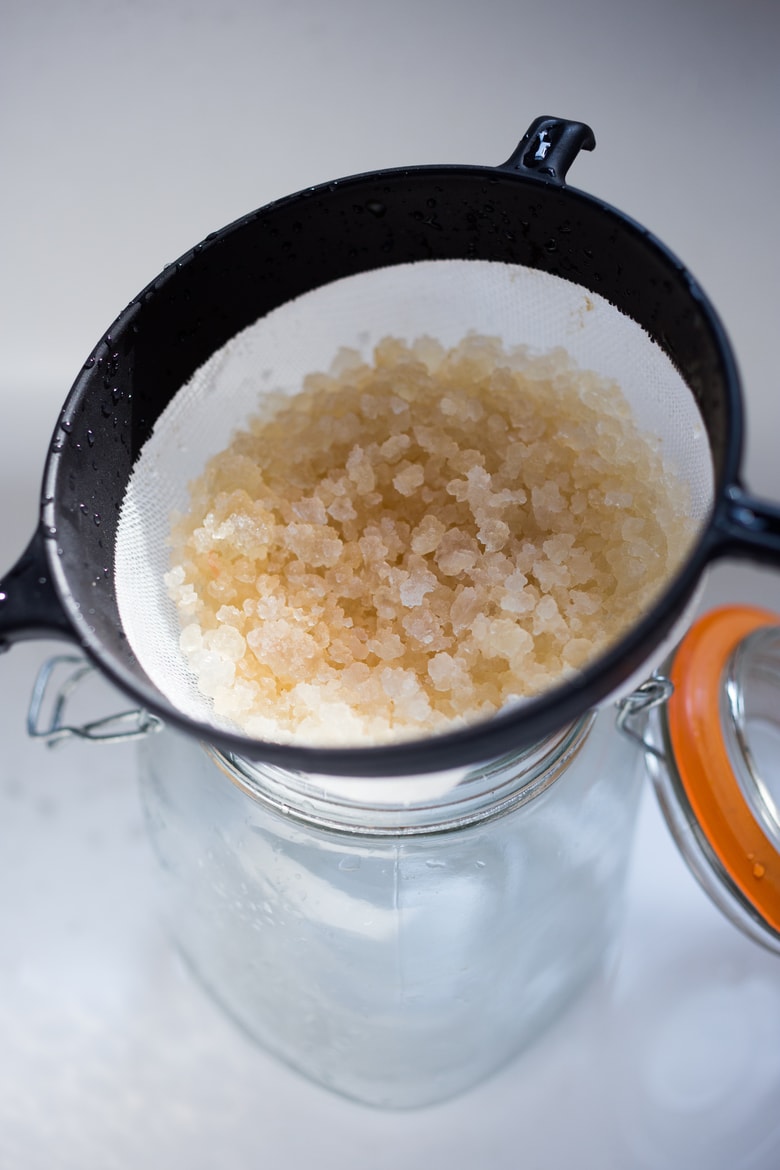
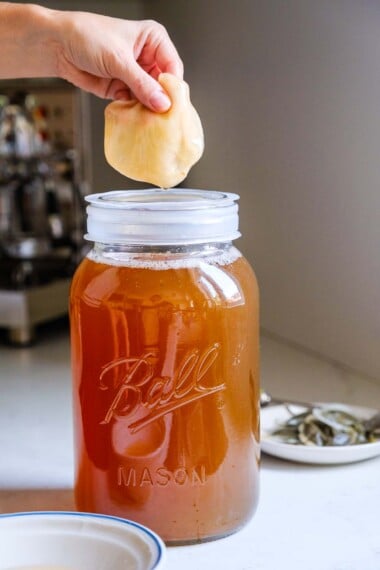
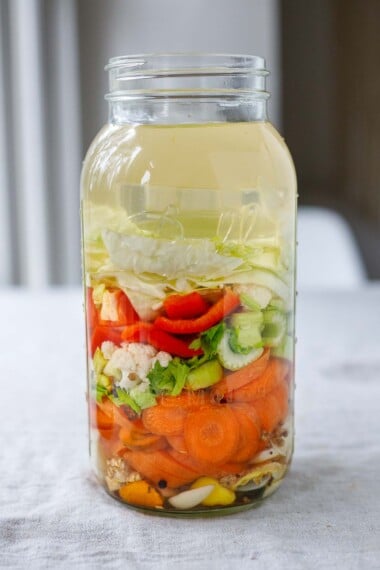
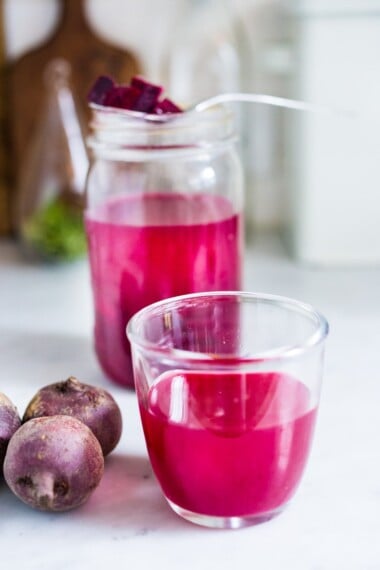
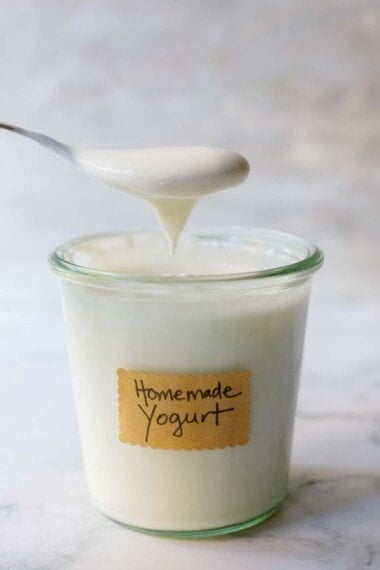
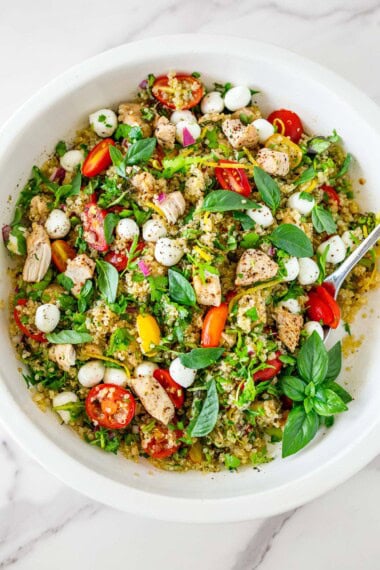

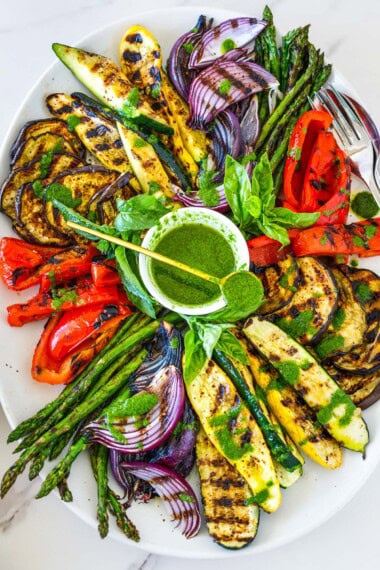



Detailed and accurate
Great to hear!
Thank you! I have grains that I tried with and my final product didn’t seem like I’d gotten it quite right. I’ve read through your instructions twice and have a batch fermenting now. Cheers!
Oh Good! Let me know how it goes!
I use plastic soda bottles for the fermentation process- easy to tell when the pressure starts to build as bottle gets hard and then release the top to release . Never had an exploding bottle yet .
I see how that would make things 100% easier, but I personally try to stay away from storing things in plastic because they can be hormone disruptors. And my hormones need all the help they can get right now. lol 😉
Can you use a metal strainer? I have read that it must be a nylon or plastic strainer or it kills the kefir grains. It’s hard to find small plastic strainers. Love to use a metal strainer if possible.
Thank you
Hi Kathy- I think briefly using stainless is totally ok, you just don’t want to store it or keep the kefir grains exposed to aluminum for long periods of time. I use a stainless strainer and have not issues.
Thank you for your reply. I will use the metal strainer judiciously. I love love the Kefir and I am actually loosing weight by drinking it daily. Improves my digestion and my immunity.
Thank you for posting this as it’s a simpler process than the one I received from the kefir grain company I ordered from.
Kathy
Great to hear Kathy!
I tried this last summer when you recommended “water kefir” so enthusiastically, but by the end of the summer I discontinued using it because of the alcohol content. Basically, through the fermentation the sugar is metabolized into alcohol, and I didn’t want to add alcohol to my diet.
I can understand that Joan. Yes,there is a teeny tiny bit. But, it is only lightly fermented (3 days) and typically it amounts to 0.02 % alcohol which would be like ¼ a teaspoon’s worth in a 8-12 ounce glass- just to give others here some perspective. 🙂
I’m going to try this! Would like to know how much you drink of this each day?
I usually just have a glass of it!
H Sylvia and team 😀 Looking for clarification before I try this 😀 Under the instructions, #4 says “Add ¼ kefir water to each jar… ” … is this a 1/4 cup or a quarter of the whole amount of liquid? Thanks so much! I can’t wait to try this and keep it going! I was looking for alternative healthy beverages to supplement our daily hydration, and with the added benefits that it sounds like water kefir will add, I’m really excited to add it to our diets! Lovin’ Feasting At Home!! You’ve enriched my meal repertoire exponentially since I found your site … years ago now! I, and my husband, thank you for that as well :D!! Warmly, Pam
Sorry about that Pam- 1/2 cup kefir water. I fixed the recipe and hope you give it a go! It’s such a fun process.
Thanks Sylvia! I have my kefir grains on order … can’t wait!
Awesome to hear!
fantastic. answered several questions
clearly and i learnt new info
thank you
Great! So glad to hear this Deborah!
Our keifer grains are diminishing instead of growing!
Oh shoot! Sometimes if the grains are overly mineralized they can diminish- well water or too much unrefined sugar can contribute to this.
Come from a cactus plant? I was sure that the kefir grain is a combination of yeast bacteria, not a plant? Maybe the cactus has been used as feed for the organisms.
Hi Jari- Yes, you are right but they are believed to originate from the pad of an Opuntia cactus in Mexico.
This is a well written, thorough recipe giving a lot of good advice on top of the actual recipe. Actually the only one you need regarding the water kefir.
Thank you for the story Sylvia, very entertaining.
Thanks so much!
But after some more research it seems that the first grains were found some cactus in Mexico and were cultivated there.
I tried to find a recipe for growing them (in four languages) and none ha an other option than to get some seed grains.
Can I use swing top bottles for the 2nd fermentation step? Would I still need to “burp” the bottles?
Yes, you would! I would. 🙂
My grains are turning to crumbs. I think it’s the water; I used rainwater, and it was fine, but now I’m using store bought spring water and they are still working, but decaying?
Thanks for your insightful inst. For the second+ fermentation, I use old 2lt bottles and add a 1/8 cup sugar. They have not yet exploded, but they sure want to if opened warm!
I stopped using fruit, I use mainly honey for a meady flavor or I use jalapenos for a good tang with Mex food. In the case of using a fruit/veg, I ferment and burp for two days, then remove and finish the ferment (when they stop forming new bubbles).
I don’t burp those 2lts, but I put them in fridge for a well carbonated drink, once they are cold! They don’t fizz over when opened cold.
Ok, good to know Reggiw! Hopefully, your grains will recover. Unfortunately there are bad things in our rainwater, glyphosates which may hurt them. But they are resilient- like us!
It’s very detailed step by step instructions. All I want to know is answered. Thank you.
Great to hear Vivian!
That’s great 👍
Love it! I do not like drinking plain water and normally drink a bunch of sparkling water but this is so much better tasting and more fun. Florida sun kefir instructions say to use some molasses as part of the sugar mix so I did. On the first try I did 2x64oz side by side with spring water & Iowa tap water, got the same results. So I did do the first fermentation in a 64oz jar as well (instead of using 2 jars and fill them halfway). It worked fine, but I could only fit about 7 cups of water in the jar so I was a bit short on the kefir for the 2nd fermentation (like there was about 3” of headspace on top).
Oh interesting Bowie- thanks for sharing! Molasses has a lot of minerals so I bet that would be good here. I will try that too!
Hi
Tank you so much for this great article. Very informative and easy to follow.
I would like to purchase some water kefir grains. Would you be able to advise on a quantity that would be suitable for one person “daily” consomption?
I found pacs of 5g or 20g etc..
i don’t want to buy to much or too little.
Please let me know
Many many Thks
Nelly (31, women, french living in London) ☺️ Hello from over here!
Hi Nelly- you’ll need 1/4 cup fed, water kefir grains to make this recipe-sorry, I’m not sure how much this weighs.
Hi Nelly! Feel free to buy the smallest amount available (usually 15g) because they will grow very fast. I bought 15g and within a few weeks had 200g and had to get rid of the excess.
Can you use decaf tea or does the buch need the caffeine to ferment?
Hi Kathy- there is no tea in this recipe- you may be thinking of Kombucha?
Love it .Thanks
Can you sub the prune for a date?
You know, I bet that would be fine!
I use raisins
Hi – these are great instructions and I’ll rate the recipe once I try it. But first–you mention “alive” kefir grains. I bought dehydrated grains. Will these work?
No Marie- they need to be activated first. Read the directions on your packaging. Get them fed and active. 🙂
Why not just use a single 2qt jar for the whole thing instead of dividing it in two?
I honestly don’t know- this is how I was taught. Feel free to experiment. 🙂
Don’t put all your eggs in one basket?
Haha! Perhaps that is it!
Can I use more cane sugar and omit the coconut sugar due to my son’s allergy? Thanks.
Yes, of course!
Thanks for this post! I think I want to try making this. Could I use a bottles with a flip top lid for the 2nd ferment? Like the ones people use for kombucha or home brew beers.
Hi Naomi, Yes, once you filter out all the fruit or any additives you are using, funneling the water kefir into the flip top bottles. You must burp these from time to time, they get wonderfully fizzy but can completely erupt if the pressure is not released.
Thanks for this helpful guide! I’ve been making it and loving it. Do you know what strains of probiotics are produced?
Thanks and happy you are enjoying it. I am not sure of the specific strains- a great question though!
Thanks for your information, I’d like to try this soon, I noticed a person selling water kefir grains locally. Can I use bottled lemon or lime juice instead of the wedge of lemon?
Also, is plain white sugar not good enough?
Plain white sugar has zero minerals in it. The minerals in our sugar blend really help the water kefir grains stay healthy and active. That being said, feel free to use white sugar on occasion- I sometimes do, just not every single time. 🙂 I am honestly not sure about the lemon juice. You could try?
After reading this article my sister & I got some Florida Sun Water Kefir grains and started making water kefir. I always loved kefir, but no longer consume dairy products, so I was very excited to try this recipe. I LOVE it! My sister had never tried kefir but has been enjoying it, especially the raspberry flavored. Thank you so much.
Thanks, Peggy- so happy this is working for you. Raspberry is my favorite!